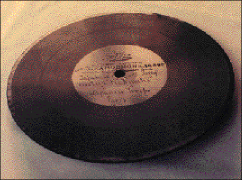
Wax-disc recordings from the turn of the century preserve performances of a Japanese theater troupe thought to have influenced Picasso and Puccini.
By Grant Madsen
When a BYU professor skimmed a catalog of foreign recordings, he had little idea he would stumble across the earliest known commercial recordings of Japanese voices belonging to an influential turn-of-the-century Japanese theater troupe that inspired such artists as Picasso and Puccini.
But that’s what professor J. Scott Miller found, and his discovery is considered a cultural and historical gem by the Japanese people.
“This is a historical treasure,” says Masakazu Watabe, BYU associate professor of Japanese. “It contains the actual voices of people we have heard and read about. To know there are actual recordings, the oldest ever recorded–that’s significant.”
The finding placed Miller, associate professor of Japanese literature at BYU, on the front page of Asahi Shimbun, one of Japan’s largest newspapers, and on Japan’s version of 60 Minutes.
Miller, whose compact disc remastering of the recordings is selling briskly in Japan, chanced upon the recordings in England while doing research for his dissertation at Cambridge University. He was looking for recordings of Japanese performers in London.
“One afternoon I was scrolling through yet another roll of microfilm, and there, in a catalog of foreign recordings from 1902, were two pages of handwritten Japanese,” he says.
Inquiries at London’s EMI record company led him to identify 29 wax-disc recordings of Japanese speech, music, and dialogue from a performance of the Kawakami theater troupe at the 1900 Paris Exposition, the earliest known recordings of their kind. Miller says the recordings were made in order to satisfy Europeans’ intense interest in things Japanese, known as japonisme.
Indeed, japonisme had such a hold on Europeans that Pablo Picasso chose the theater group’s star as the subject of one of his sketches.
“Picasso actually made a sketch of Sadayakko, the main performer and dancer of the troupe. Europeans were fascinated by her,” says Yoko Chiba, a professor of Japanese at St. Lawrence University in New York. “What made her and the Kawakami troupe so powerful, popular, and appealing is the immediate association people made with popular imported ukiyo-e prints. Sadayakko brought the prints to life.”
Evidence also shows the Italian composer Giacomo Puccini lifted melodies from the Kawakami troupe’s performances while composing his famous opera Madame Butterfly.
“In April 1902 Puccini saw the troupe perform in Milan, Italy,” explains Arthur Groos, Cornell professor of musicology and co-editor of the Cambridge Opera Journal. “It’s fairly clear he obtained, either from watching the performance or from a recording, some of the Japanese music.”
The melodies had an obvious impact on Puccini because “he went home and four days later wrote the entrance music of act 1 using one of the melodies he heard from the theater,” Groos says. “Scott’s discovery is important because for the first time in Western history, knowing a composer heard certain melodies, we can actually hear what he heard.”
Miller’s discovery is also significant to Japanese linguists because it provides recorded examples of Japanese speech near the turn of the century.
“From the Japanese point of view, it is interesting and helpful to know how they spoke then,” says Watabe, a native of Yokohama, Japan.
Watabe says the Japanese are interested in the world of science and in scholarship, and Miller’s discovery is an honor for BYU. “More than just bringing attention to BYU’s Japanese language program, it gives visibility to BYU as a whole. Many Japanese people know Harvard, Princeton, or Stanford, but they don’t know BYU. This discovery will help fix that to a certain degree.”
Miller’s CD has been nominated by the Agency for Cultural Affairs, part of the Japanese Ministry of Education, for a fine arts award for recording. The CD can be ordered through BYU’s Creative Works catalog by calling (800) 962-8061.









